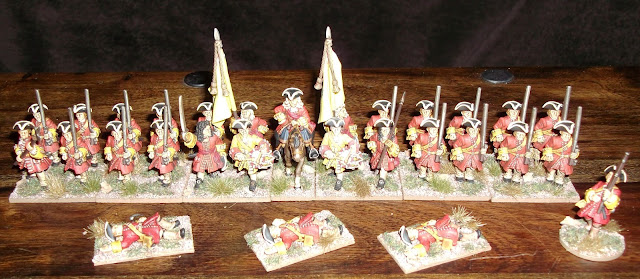The first part of this comparison will look at the three shades of dip available from Army Painter, the soft, strong and dark. These three all work in the same way of course, it really is just a case of the tone. These are oil based and quite thick, something that leads many to no small concern. Pushing a painted figure into this gloopy dip does take some bravery to begin with but with proper care and attention the results are worth it. However, much will depend upon which shade of dip you try as the results are quite different.
For ease of comparison I painted four of the same figure in exactly the same way using the same colours. The painting is very basic, just base colours blocked in. The picture below shows an undipped figure on the left followed to the right by the soft tone dip, strong tone and then dark tone.
Army Painter themselves suggest that strong tone should be the default dip of choice, and I can see why. It is the one I use for most things but much will depend upon personal choice and the type of figure you are painting; various colours will work better with different shades. In this picture it is quite clear that any shade will alter the base colours. The soft tone has done this with the minimum of shading. The strong tone (figure three) is very different. The colours have changed far more and there is a lot of shading, I think faces do very well with dip and look more natural. Figures with painted eyes just look odd and creepy. The dark tone dip on the far right is very different. The grey base colour has masked some of the shading but kept a degree of depth, it looks a little less 'dirty' perhaps than the strong tone figure. Army Painter suggest that the soft tone is better used on predominantly light coloured figures, Napoleonic Austrians or 18th C. French etc. I can see the logic of that for the uniform colour but I prefer the definition that the other colours provide. So I tried the dark tone on white to see what happened.
The next picture compares the strong and dark tone. I should point out that the red used is different on both figures. The Marlburian figure on the left used the Army Painter pure red spray, the other figure a basic bright red from my paint box. Sorry, doesn't help I know, but it is the white bit I am looking at.
Now I do not think that the dark tone dip on the white of this Black Scorpion Marine looks too bad at all. In fact, I would be tempted to use that rather than the strong tone I normally favour in these cases. Imagine though, the initial concern of plunging your nicely painted white figure into what looks like black paint; a bit of a worry until you see the results. I should stress here that I do dip my figures and then spend some time...and a lot of energy...shaking the dip off in an even and controlled manner; not the 'shake three times and you're done' method suggested by Army Painter.
I am not at all sure that the more brown coloured strong tone would have worked half as well on the marine figure. It does work very well on the more red based Marlburian though whereas the dark tone may have been to bold. This example shows well how the choice of dip can be dependant upon the figure colour and possibly be counter-intuitive too.
The next picture compares the Army Painter strong tone with the Vallejo acrylic dip, the sepia shade in this case.
This next picture shows a selection of figures painted with the acrylic dip. Again, basic paint job of block colour only.
I think these have come out quite well with relatively little work. The acrylic dip has been painted on
rather than dipped. It even works well with monsters!
So, has this post been of any use to you, dear reader? Let me know, I would love to hear your views.













